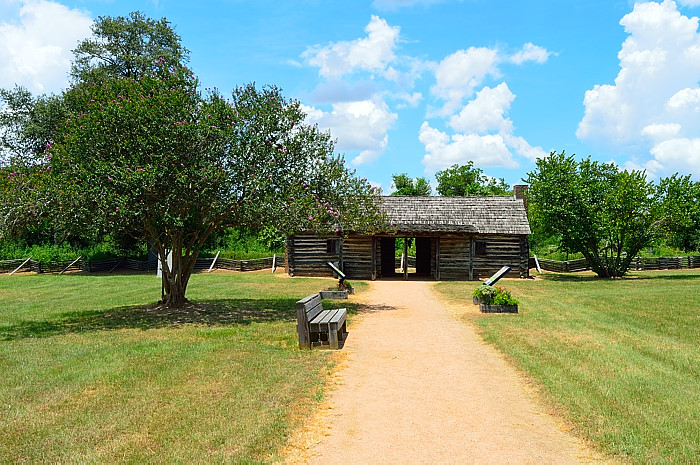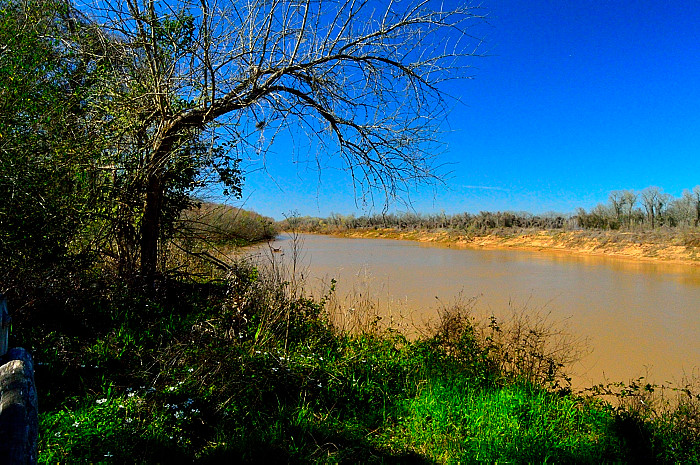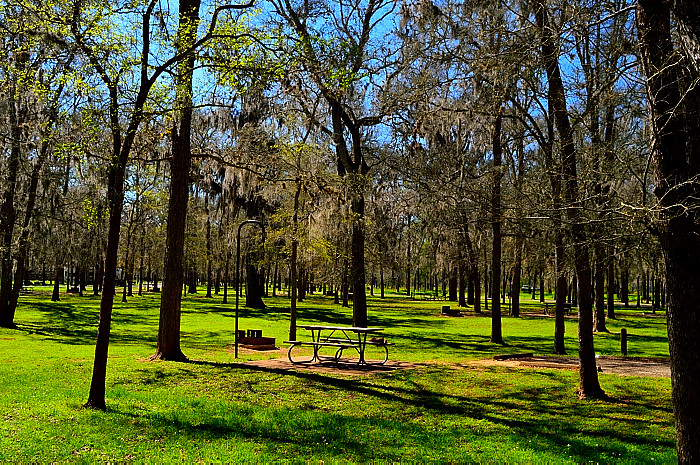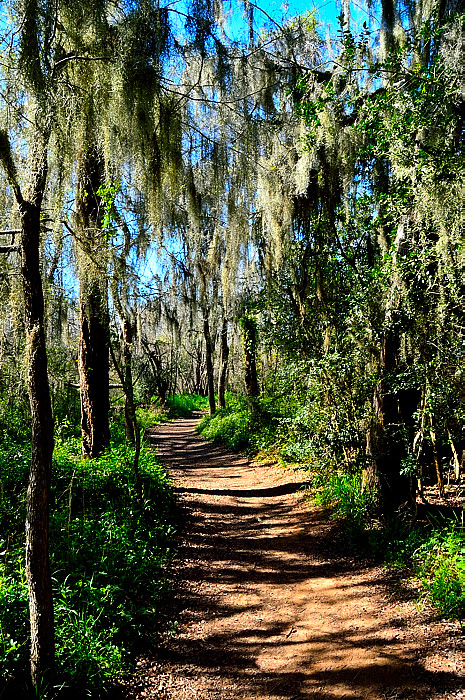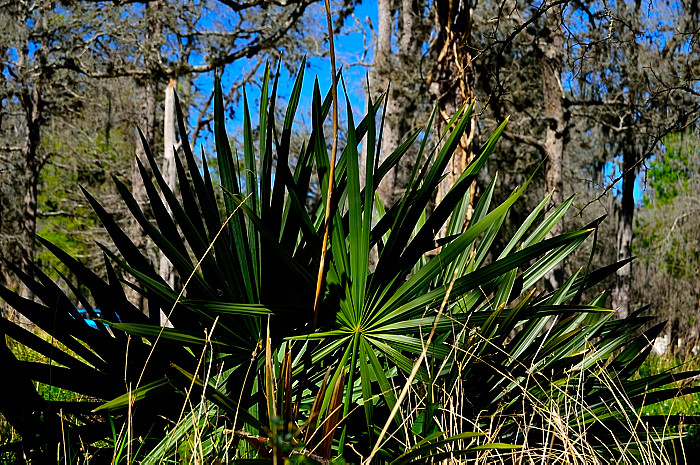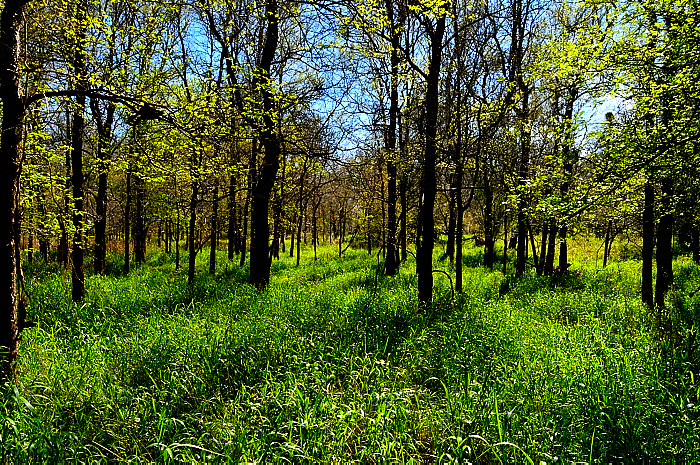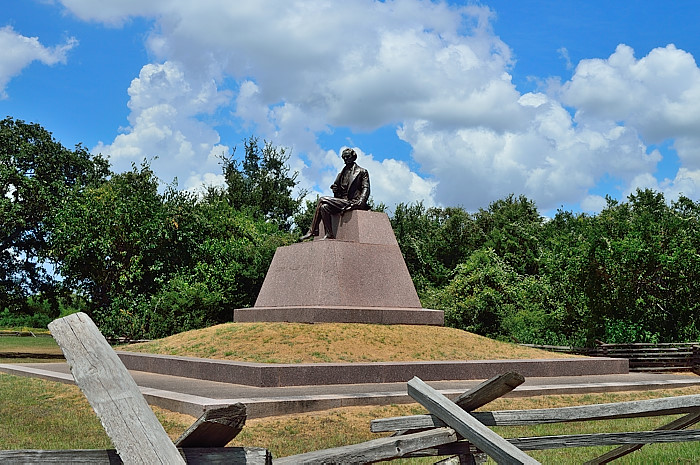It’s a chance discovery, totally unintended. We’re about 50 miles outside Houston on the road to Stephen F. Austin State Park. Up there on the left are a couple buildings and a statue. We pull in to get a closer look. The sign says “San Felipe de Austin State Historic Site.” Turns out, this is one of the most significant archeological and historic sites in Texas—this is sacred ground.
It’s a noiseless day, the sky is the color of polished pearl. If you listen carefully near the pink granite obelisk you can hear quiet whispers from the past. Could be the wind murmuring through the old dog-run cabin. Could just be the rustle of cottonwood leaves, now gone russet yellow. No, it’s a voice all right—dim but durable. The history of Texas speaks with many heroic voices, but few are as consequential as this one. Here, at the capital of the American colonies in Texas, the story of Stephen F. Austin is told. Just a mile down the road lies the entrance to the state park which carries his name.
My first impression of the park is of seclusion and exclusiveness. There’s a sense of country club chic to it, like some secret getaway for members only. From outside the front gate, imposing rock palisades protect what looks like a splendid Southern estate. The sun bleeds through swampy forest canopies thick with moss and hanging vines. The grass is dark green and freshly mown around the main building. Behind an immaculate white fence lies a plush and busy 18-hole public golf course. Sprawling cedar elms, sycamore and hickories provide dense shade on this hot malarial day. The thick undergrowth is marbled with coralberry, dwarf palmetto and grapevine. At only 473 acres, Stephen F. Austin State Park is small but popular. . .it’s crowded for a weekday.
The tenor of activity here is dominated by the Brazos River which lives on the north end of the park—sometimes overwhelms it. A significant river in Texas, the Brazos is a ponderous slow-moving waterway under normal circumstances. There is an overlook near a bend in the river where hikers can get a firsthand look at its erosive power. The flow cuts deeply on the outside of the bend and moves rich soil to the inside of an elbow, leisurely altering its own course over time. But when substantial rains fall, the river surges out of its banks engulfing large portions of the park. Flooded areas can be closed for months. It’s one of the risks of living next to big water. Be sure to call ahead or check the park website for conditions before heading out.
Stephen F. Austin State Park does have overnight camping, but it appears most patrons come for the day. It’s no wonder. A quiet drive through the park reveals seemingly endless picnic tables, each with a grill. The picnic grounds are flat bottomland, deeply shaded and verdant. Separation is generous and privacy is foremost. A playground in the common area sports two swing sets, a basketball court, a volleyball court, and a horseshoe pit with public restrooms close by.
Also, on the grounds is a 1.75-mile orienteering course for more adventuresome guests. Screen shelters and cabins dot the periphery of a gently curved access road. A group picnic pavilion is secreted away on the back portion of the park while a screened group recreation building with dining hall, restrooms and showers offers still another public venue. Near the recreation hall is a nature center dedicated to interpreting the birds, critters, and ecology of the region. Once you leave the day use area, however, the land turns immediately thick and wild.
Hiking here is a near jungle experience with tall hardwoods, profuse understory, mosses, overhead vines, and upland swamp. Trails are clear and wide, but park staff do not hesitate to close them when muddy. In the shaded areas, great stands of inland sea oats are a dead giveaway that water is nearby. Wherever the sun scratches a way through, you’ll find spikey green clumps of palmetto drowsing in summer sun-gold. Possum haw and Turk’s cap are also prevalent.
There are over 5 miles of hike/bike trails on the property but, given the undergrowth, it seems like a lot more. A 1/8th mile self-guided, interpretative nature trail is designed for wildlife viewing and to showcase birds that frequent the park as a stop-over for migration or as a nesting site for the season. Near one of the trailheads is a 30-person amphitheater. The trail system also provides access to the Brazos River; bank fishing is allowed—flathead catfish abound in these waters.
The critters that hang out in this riparian habitat are what you would expect. With plenty of water and cover, white-tailed deer, beavers, rabbits, and squirrels rule during the day. Armadillos, raccoons, and opossums come out at night. Bobcats hunt here too. As for our feathered friends, it depends greatly on what time of year you visit; however, some of the more unique common residents include yellow-billed cuckoos, white-eyed vireos, Mississippi kites, and northern parulas. The forest provides natural habitat for pileated woodpeckers and good hunting grounds for owls and red-shouldered hawks. Various warblers also frequent these woods.
Want a special treat? The park becomes magical when the sun goes down. Away from the glare of the city, stargazing here is unmatched. As you look up with wonder at the silver pepper of stars overhead, be sure to listen for the distinctive call of the barred owl when she comes to life among the treetops. One superior nighttime indulgence is the cavalcade of fireflies which light up the darkness in May and June. It’s a limited-time engagement and an unforgettable show—as if they know they’re on parade!
Do include a visit to the state historic site mentioned in the introduction. It’s a monument to Texas tenacity as well as a poignant history lesson. In 1823, Stephen F. Austin (A.K.A. the “Father of Texas”) with help from then land commissioner Baron de Bastrop, brought the first 297 families to Texas under a contract with the Mexican government. He set up a community near the Brazos River, being careful to ensure a defensible location protected from flooding, with nearby creeks, a water well, and an operating ferry. This served as the homeland of American colonies in Texas, the center for all social, economic, and political activity for thirteen years. Milestone institutions were born here, to include “The Texas Gazette” (our first Anglo newspaper), the Texas postal system, and the celebrated Texas Rangers.
The 14-acre historic site was donated to the State of Texas in 1940. Today, this otherwise unassuming site is dominated by a huge bronze statue of Stephen F. Austin—you can’t miss it! You’ll discover a restored general store and museum, originally built in 1847, as well as a replica of the old log cabin where Austin lived and conducted business. There’s also numerous other markers on the site to commemorate the achievements of Austin and his colonists. Depending on your interest, on a weekday you’re looking at, maybe, a half-hour stop. If you want more, make sure to come in the afternoon on a Saturday or Sunday. That’s when the Stephen F. Austin Park Association gives public tours of the museum and site.
Taken as a double-barreled attraction, Stephen F. Austin State Park offers a diverse choice of exploration, just an hour-and-a-half’s drive from Bastrop. Nestled outside the small town of Sealy, off Interstate 10, the destination is an enjoyable day trip for golfers, fishermen, hikers, picnickers, overnight campers, birders, and nature photographers—not to mention malingering slackers just looking for some quiet time in the woods. The state historic site is a great educational experience for grandkids, school groups and Texans of all ages. So, there you are. No longer can you complain about nowhere to go or nothing fun to do. Get out of the house, pack a picnic, and hit the road!
By Larry Gfeller


